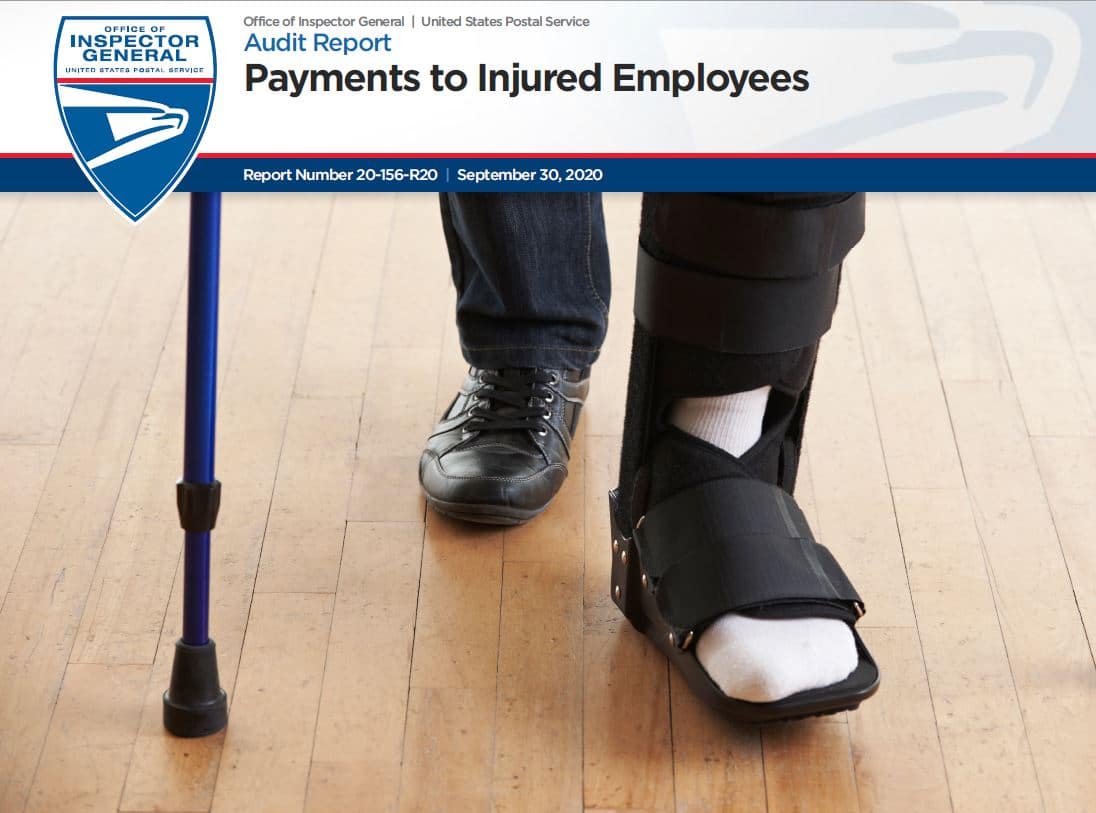Objective
Our objective was to determine whether the Postal Service is properly paying its injured employees.
Postal Service employees are covered by the Federal Employees’ Compensation Act (FECA). The U.S. Department of Labor’s (DOL) Office of Workers’ Compensation Programs (OWCP) administers FECA, determines injured employees’ eligibility for benefits, and pays direct compensation to claimants or their beneficiaries. In 1974, FECA was amended, increasing benefits and significantly changing the law by adding provisions such as continuation of pay, which allows for an employee to elect to continue receiving salary from the employer, in lieu of annual or sick leave, for up to 45 days if the employee is absent from work due to disability or medical treatment from a work-related injury. The Postal Service is responsible for paying the injured worker continuation of pay while DOL adjudicates the workers’ compensation benefit claim. The DOL will begin making payments, following adjudication, to compensate for the loss of wages or wage-earning capacity due to the job-related injury.
Employees may receive both salary from the Postal Service and workers’ compensation payments from DOL for the same payroll period, but those payments cannot be for the same workhours, except when an employee has suffered a loss of wage-earning capacity as the result of the job-related injury. The Postal Service reimburses the DOL each year through a chargeback process. For the 2018 and 2019 chargeback years, the Postal Service reimbursed the DOL over $1.3 billion each year.
Workers’ compensation disability payments are payments made to injured employees for the loss of wages or wage-earning capacity and do not include reimbursement for incurred medical costs. In chargeback years 2018 and 2019, disability compensation totaled over $800 million for each year.
Our audit was in the fieldwork stage when the President of the U.S. issued the national emergency declaration concerning the novel coronavirus disease outbreak (COVID19) on March 13, 2020. The results of this audit do not reflect any process and/or operational changes that may have occurred as a result of the pandemic.
Findings
The Postal Service did not always properly pay injured employees who elected to receive continuation of pay prior to receiving workers’ compensation benefits. Using data analytics, we identified and selected all 155 transactions in which workers’ compensation claimants charged 80 or more continuation of pay hours to their timecards while they received workers’ compensation payments during calendar years 2018 and 2019. The Postal Service duplicated payments in 97 of 155 transactions by paying continuation of pay benefits directly to the injured employees and also reimbursing the DOL for workers’ compensation payments for the same workhours.
In addition, for 71 of the 97 transactions, the Postal Service provided continuation of pay benefits beyond the maximum 45-day limit. As a result, the Postal Service overpaid these injured employees $126,202.
Further, the Postal Service did not always process OWCP claims accurately and timely. We statistically selected a sample of 207 out of 439,491 transactions between January 2018 and December 2019 in which injured employees were paid by the Postal Service for normal workhours and also received workers’ compensation benefits for the same payroll period. The Postal Service processed 97.6 percent of the transactions properly; however, five transactions were not accurately or timely processed. Specifically:
- Two injured employees’ supervisors did not timely inform Human Resources management that an employee returned to full-time work or was working hours in excess of those determined by the OWCP based on the disability. We referred one of these cases to our Office of Investigations for further review.
- An injured employee claimed the same hours on two separate claims for compensation and Human Resources management approved both claims. We reviewed payroll records for four months prior to and after these two claims and did not identify any additional issues.
- Two injured employees’ field supervisors did not enter OWCP-Leave Without Pay hours in the payroll system.
Management stated that field supervisors and district personnel missed these items during the payroll or claims approval process. In addition, the Postal Service workers’ compensation program is a manual process that heavily relies upon timely coordination and accurate information between district personnel, field supervisors, and employees.
Because the Postal Service did not process OWCP claims accurately and timely, we estimated it overpaid injured employees $3.9 million annually in workers’ compensation benefits during calendar years 2018 and 2019, and will overpay $3.9 million annually in calendar years 2020 and 2021 if corrective actions are not taken to address the issues.
Recommendations
We recommended management:
- Reiterate to field supervisors the requirement to input continuation of pay hours in the payroll system.
- Enhance systems to automatically calculate days of continuation of pay per employee and limit supervisor ability to enter continuation of pay hours when the 45-day limit is reached.
- Reiterate to field supervisors the requirement to timely communicate to Human Resources management when injured employees return to work or experience change in pre-determined work hours; and to record workers’ compensation leave without pay hours.
- Enhance relevant systems to provide automated tools and edit checks to reduce reliance on manual procedures during the payroll and claims approval process.
Read full report
Source: USPS Office of Inspector General

